TOP-1000 of the Far Eastern companies
In order to reduce interregional inequality of the quality of life, accelerate the rates of economic growth and technological development, as well as to ensure the national safety of the country, in February 2019 the Government of Russia adopted the Spatial development strategy of the Russian Federation until 2025, and defined 12 macroregions. One of them is the Far Eastern region, including Amur, Magadan and Sakhalin regions, Jewish autonomous region, Kamchatka, Primorye and Khabarovsk territories, the Republic of Sakha (Yakutia), and Chukotka autonomous district.
Information agency Credinform has prepared a review of trends of the largest companies of real economy in the Far Eastern region.
The largest enterprises (TOP-1000) in terms of annual revenue were selected for the analysis according to the data from the Statistical Register for the latest available periods (2013-2018). The analysis was based on the data of the Information and Analytical system Globas.
Net assets are total assets less total liabilities. This indicator reflects the real value of the property of an enterprise. When the company’s debt exceeds the value of its property, the indicator is considered negative (insufficiency of property).
The largest company of the Far Eastern economic region in term of net assets is JSC ALROSA, INN 1433000147, the Republic of Sakha (Yakutia). In 2018, net assets value of the company amounted to 334 billion RUB.
The lowest net assets value among TOP-1000 was recorded for LLC RIMBUNAN HIJAU MDF, INN 2721143979, Khabarovsk territory. In 2018, insufficiency of property of the company was indicated in negative value of -14 billion RUB.
Covering the five-year period, the average net assets values of TOP-1000 companies has a trend to increase (Picture 1).
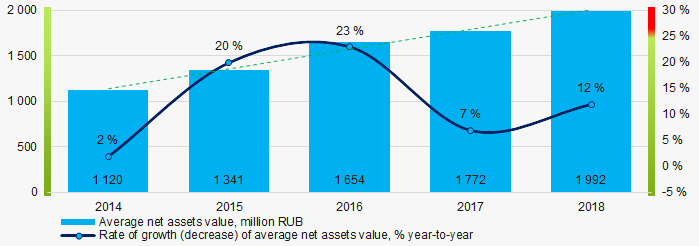 Picture 1. Change in average net assets value in 2014 – 2018
Picture 1. Change in average net assets value in 2014 – 2018The shares of TOP-1000 companies with insufficient property have trend to decrease over the past five years (Picture 2).
 Picture 2. Shares of companies with negative net assets value in TOP-1000
Picture 2. Shares of companies with negative net assets value in TOP-1000Sales revenue
In 2018, total revenue of 10 largest companies of the region was almost 45% of TOP-1000 total revenue (Picture 3). This testifies high level of concentration of capital.
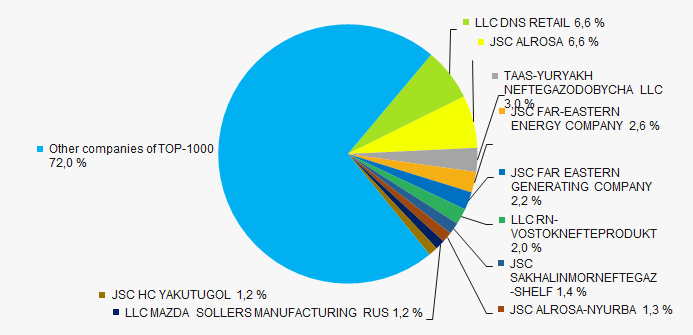 Picture 3. Shares of TOP-10 companies in TOP-1000 total profit for 2018
Picture 3. Shares of TOP-10 companies in TOP-1000 total profit for 2018In general, there is a trend to increase in revenue (Picture 4).
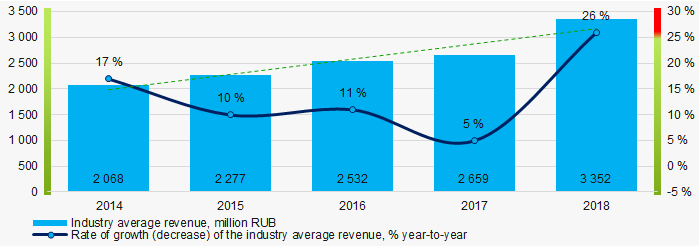 Picture 4. Change in industry average net profit in 2014 – 2018 годах
Picture 4. Change in industry average net profit in 2014 – 2018 годахProfit and loss
The largest company in term of net profit is Taas-Yuryakh Neftegazodobycha LLC, INN 1433015633, the Republic of Sakha (Yakutia). In 2018, the company’s profit of 54 billion RUB was recorded.
Covering the five-year period, there is a trend to increase in average profit of TOP-1000 companies (Picture 5).
 Picture 5. Change in industry average profit values in 2014 – 2018
Picture 5. Change in industry average profit values in 2014 – 2018Covering the five-year period, the average net profit values of TOP-1000 companies have the increasing trend with the decreasing average net loss value (Picture 6).
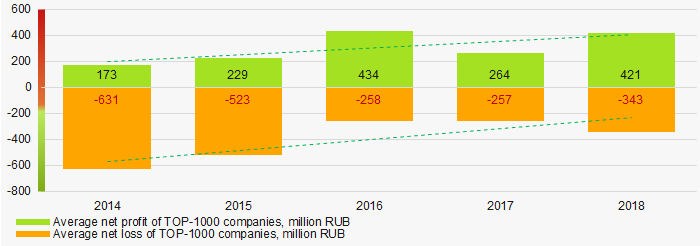 Picture 6. Change in average net profit and net loss of ТОP-1000 in 2014 – 2018
Picture 6. Change in average net profit and net loss of ТОP-1000 in 2014 – 2018Key financial ratios
Covering the five-year period, the average values of the current liquidity ratio were significantly above the recommended one - from 1,0 to 2,0 with a trend to increase (Picture 7).
Current liquidity ratio (current assets to short-term liabilities) shows the sufficiency of company’s assets to repay on short-term liabilities.
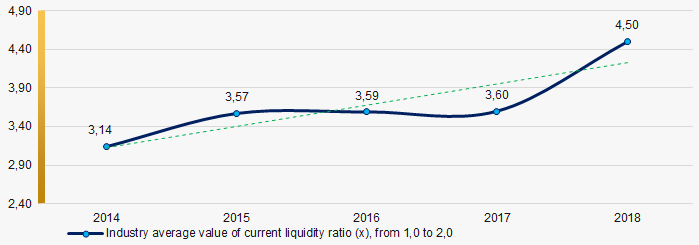 Picture 7. Change in industry average values of current liquidity ratio in 2014 – 2018
Picture 7. Change in industry average values of current liquidity ratio in 2014 – 2018During four out of five years, relatively high level of average ROI values was recorded with a trend to decrease (Picture 8).
ROI ratio is calculated as net profit to sum of shareholders equity and long-term liabilities, and shows the return of equity involved in commercial activities and long-term borrowed funds
 Picture 8. Change in average values of ROI ratio in 2014 – 2018
Picture 8. Change in average values of ROI ratio in 2014 – 2018 Assets turnover ratio is the ratio of sales revenue and company’s average total assets for a period. It characterizes the effectiveness of using of all available resources, regardless the source of their attraction. The ratio shows how many times per year the full cycle of production and circulation is performed, generating the corresponding effect in the form of profit.
Covering the five-year period, business activity ratio demonstrated the decreasing trend (Picture 9).
 Picture 9. Change in average values of assets turnover ratio in 2014 – 2018
Picture 9. Change in average values of assets turnover ratio in 2014 – 2018Small enterprises
47% companies of TOP-1000 are registered in the Register of small and medium-sized enterprises of the Federal Tax Service of the Russian Federation. At the same time, their share in total revenue of TOP-1000 is about 12% that is significantly lower than the national average figure (Picture 10).
 Picture 10. Shares of small and medium-sized enterprises in TOP-1000
Picture 10. Shares of small and medium-sized enterprises in TOP-1000Main regions of activity
Companies of TOP-1000 are registered in 9 regions and located quite unequally. Almost 52% companies largest in term of turnover are concentrated in Primorye territory and the Republic of Sakha (Yakutia) (Picture 11).
 Picture 11. Distribution of TOP-1000 revenue across the Far Eastern economic region
Picture 11. Distribution of TOP-1000 revenue across the Far Eastern economic regionFinancial position score
Assessment of the financial position of TOP-1000 companies shows that the majority of them have financial position above average (Picture 12).
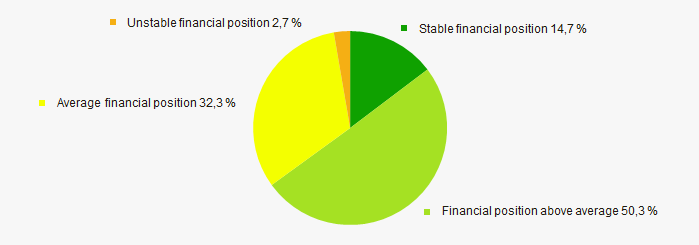 Picture 12. Distribution of TOP-1000 companies by financial position score
Picture 12. Distribution of TOP-1000 companies by financial position scoreSolvency index Globas
Most of TOP-1000 companies got Superior / High and Strong / Medium index Globas. This fact shows their ability to meet their obligations fully and by the due date (Picture 13).
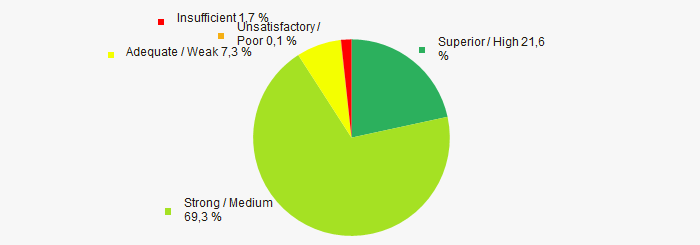 Picture 13. Distribution of TOP-1000 companies by solvency index Globas
Picture 13. Distribution of TOP-1000 companies by solvency index GlobasIndex of industrial production
According to the Federal State Statistics Service (Rosstat), during 12 months of 2019 - 2020, the trend to decrease of industrial production indexes is observed (Picture 14). The average month-to-month figure was 100,3%.
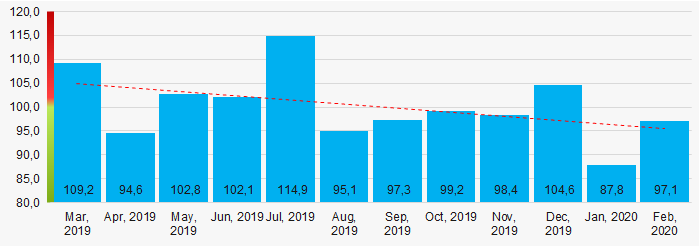 Picture 14. Index of industrial production in the Far Eastern economic region in 2019 - 2020, month-to-month (%)
Picture 14. Index of industrial production in the Far Eastern economic region in 2019 - 2020, month-to-month (%)According to the same data, the share of companies of the Far Eastern economic region in the volume of revenue from sales of products, goods, works and services in 2019 was 2,838% countrywide. This figure is higher that that of 2018 with 2,763%.
Conclusion
Complex assessment of activity of the largest companies of real economy sector of the Far Eastern economic region, taking into account the main indexes, financial ratios and indicators, demonstrates the prevalence of positive trends (Table 1).
| Trends and evaluation factors | Relative share of factors, % |
| Rate of growth (decline) in the average size of net assets |  10 10 |
| Increase / decrease in the share of enterprises with negative values of net assets |  10 10 |
| Level of competition / monopolization |  5 5 |
| Rate of growth (decline) in the average size of revenue |  10 10 |
| Rate of growth (decline) in the average size of profit (loss) |  10 10 |
| Growth / decline in average values of companies’ net profit |  10 10 |
| Growth / decline in average values of companies’ net loss |  10 10 |
| Increase / decrease in average values of total liquidity ratio |  5 5 |
| Increase / decrease in average values of return on investment ratio |  -10 -10 |
| Increase / decrease in average values of asset turnover ratio, times |  -10 -10 |
| Share of small and medium-sized businesses in the region in terms of revenue being more than 22% |  -10 -10 |
| Regional concentration |  -5 -5 |
| Financial position (the largest share) |  10 10 |
| Solvency index Globas (the largest share) |  10 10 |
| Industrial production index |  -5 -5 |
| Dynamics of the share of revenue in total revenue across the RF |  10 10 |
| Average value of relative share of factors |  3,8 3,8 |
 positive trend (factor),
positive trend (factor),  negative trend (factor).
negative trend (factor).
Russia is switching to the remote economy
COVID-19 pandemic invaded the global economy. On the background of OPEC+ failed deal and falling indices, the people faced to the new crisis not connected with financial and market conditions.
The Russian companies arrange for their employees to work from home. How this will influence the business? How the state will support entrepreneurs to bridge over the difficulties?
Being the key development model, globalization does not stand the test. Quarantine and self-isolation of the countries force entrepreneurs to resort to technologies and remote office practices. The current crisis will be undoubtedly resulted in financial losses, especially in transport, tourism and production sectors. However, along with obvious challenges, distance working has some advantages.
Challenges and advantages of distance working
| No. | CHALLENGES | ADVANTAGES |
| 1 | In case of global quarantine, smokestack industries will suffer the highest losses due to disability to stop manufacturing, like metallurgy for instance. Transport, tourism, hotel, restaurant and entertainment business, as well as mass market with a significant import share should expect serious difficulties. |
Media, IT companies, marketing, advertising, creative professions, recruiters, personal assistants, and sales managers will be able to switch to the remote economy format more easily than others will. Online platforms for food delivery and provision of services will increase their revenues. |
| 2 | The breaking of traditional economic ties will lead to a long-term decline in industry and services in the USA, EU, China and other countries, which will cause a global recession, undermining world trade and the inevitable search for a new development model. According to the data for January-February 2020, the annual decline in industrial production in China is 13,5%. The decline reached 13% in the service sector, which was a record high over the past 40 years. The Purchasing Managers' Index (PMI) of 19 EU countries in March fell to 31,4 points from February's level of 51,6 points. This indicator is the lowest in history. A value of more than 50 points indicates an increase in business activity, below - a decline. |
Due to the forced curtailment of cooperation between countries and the closure of borders, a number of states can receive certain economic benefits: start reindustrialization, revive local production and the national services sector, and build supply chains within their territory. A quick response to the situation will help to occupy a certain share in foreign markets. Countries with the necessary resource base, scientific and technological potential, and low dependence on imports will take advantage of the crisis. |
| 3 | Current events will strengthen the discussion in the professional community about the need to reduce the human factor in a number of professions. | The remote economy will give a new impetus to the maximum automation of business processes. |
| 4 | In case of protracted crisis, companies with no experience in remote working will begin to downsize. | The transfer of employees to remote work will help reduce the costs of enterprises and avoid wholesale redundancy. |
| 5 | According to the experts, less than half of the Russian employers are ready for complete transferring the employees to remote work. | The following large companies have transferred to remote work: Yandex, Rambler, RT, as well as companies of the real sector such as Gazprom Neft, Igristie vina, etc. |
| 6 | Remote work has no firm schedule for the beginning and the end of the working day. Employees work more often in the evenings and on weekends. The combination of professional and household activities can cause conflicts and affect the results. | Transferring employees to a remote work will reduce rental payments, and specialists themselves will be able to save time and money to get to work. The schedule is becoming more flexible. |
| 7 | Overstaffed companies with no firm job descriptions, when employees do work without scope and timing, will face difficulties to switch to a remote mode. Many employees have never worked outside the office. | Remote work requires a specific setting of goals, objectives and deadlines for employees. This implies their complete independence in planning their time. It is necessary to create a performance management system and evaluate the result of work taking into account the changed working conditions. |
| 8 | The organization of corporate chats, CRM-systems that will allow quickly monitoring the implementation of the plan and discussing working issues will require costs from companies. | The market offers many solutions for remote work. Companies that implemented them will suffer fewer losses under global quarantine. To maintain productivity and involvement in the work, there are modern IT solutions: webinars, messengers, corporate mobile applications and platforms, and much more. |
| 9 | Currently, according to labor laws, an employee can choose any one type of employment: remote or traditional. Laws do not provide for combining remote work and staying in the office, but in practice, it occurs, often with cuts in benefits and material incentives for such specialists. | Changes in the Labor code will allow legalizing the remote work, which many employees are now transferring to because of the outbreak of COVID-19. In February, the co-chair of the All-Russia People's Front central headquarter, Aleksey Komissarov, sent a letter to the Deputy Prime Minister Tatyana Golikova, which was accompanied by a bill to include the item “Temporary remote work” in the Labor code. This form of work is established on the basis of an additional agreement to the employment contract. The employee will be able to choose a place for remote work independently. If an employee complies with established labor standards, salaries should not be reduced. The proposal has not yet been considered, but if it moves to the stage of the bill and is accepted, it will help regulate remote work.The proposal has not yet been considered, but if it moves to the stage of the bill and is accepted, it will help regulate remote work. |
| 10 | Transferring to remote work under the minimizing business contacts with partners both within the country and abroad, there is an increased risk of cooperation with unreliable company. | The increasing need for information resources that allowing to collect and analyze information about the counterparty online. |
The crisis raised the acute question of sustainability in the face of global challenges not only for business, but for the entire countries. The dynamics of the recession and subsequent recovery of GDP in the countries of the world will make it possible to estimate the effectiveness of the state and the incentive supporting measures for the economy.
Supporting measures for the Russian economy
- For microenterprises, small and medium-sized businesses, the size of insurance premiums to social funds will be reduced from 30% to 15% for salaries exceeding the minimum wage; for salaries at the minimum wage level or lower, the rate will remain 30%. A reduced rate is entered on an ongoing basis.
- A six-month tax deferral (excluding VAT) is introduced for microenterprises, small and medium-sized businesses having difficult financial situation. In addition to tax deferral, microenterprises have an option not to pay insurance premiums to social funds over the next 6 months.
- A six-month deferral of credit payments for microenterprises, small and medium-sized businesses having difficult financial situation. State subsidized loans.
- Suspension of bankruptcy proceedings (moratorium) at the initiative of creditors for companies from affected sectors for 6 months.
- The list of affected industries will be adjusted and updated by the Government of the Russian Federation.
- A 15% tax is imposed on interest income and dividends received on offshore accounts.
- A 13% tax is imposed on interest income on bank deposits and investment in securities, provided that the total amount of funds exceeds 1 million RUB.
- The government will raise an anti-crisis fund of 300 billion RUB, aimed at supporting the economy.
- Since March 17, restrictions for transport providing deliveries to retail chains have been lifted.
- “Green corridor” at customs for essential goods. The zeroing of import duties for a specific list of goods is discussed.
- Cancellation of control and supervision measures, including tax and customs before May 1. Exception is unscheduled inspections in case of threat to life and health.
- Temporary deferral of payments for the lease of state and municipal property.
- Coverage of damage to transport companies related to non-refundable tariffs for air transportation and transportation of citizens from abroad.
- Deferral of payment of dividends by state-owned companies for up to six months.
- Recapitalization of leasing companies.
- Allocation of additional funds of JSC SME Corporation expand support for small and medium-sized enterprises.
- Informing organizations about anti-crisis measures through the taxpayer’s office on the website of the Federal Tax Service.
- Expanding the list of systemically important companies.
Whether the measures will be effective and sufficient, whether small and medium-sized businesses will be able to take advantage of them, and whether bureaucratic barriers arise for fulfilling the promises of the President, the near future will show.
In conclusion, we would like to wish you good health, and your companies to rebuild business processes quickly and without damage, without difficulty transferring employees to remote work as one of quarantine measures, not stopping the business and experiencing a difficult situation with minimum losses.